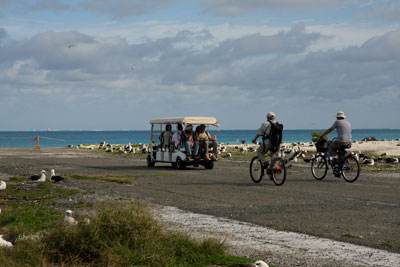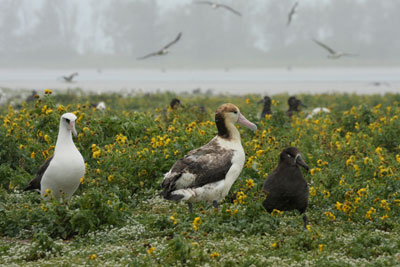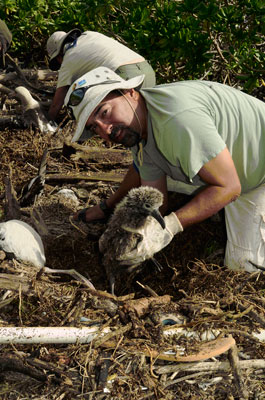Midway and the tsunami
As a tour operator, I was on Midway Atoll in March ’11 escorting a group of 15. Part of the Hawaiian Archipelago, the atoll is an unincorporated US territory, but everyone needs a valid passport to visit, even US citizens. Midway is probably best known as the site of the Battle of Midway, during WWII the turning point of the war in the Pacific.
The atoll is part of — and is the only access to — Papahānaumokuākea Marine National Monument, one of the largest marine conservation areas in the world. The coral reefs, islands and waters of the monument provide refuge and habitat for roughly 7,000 marine species.
The three small islands of the atoll — Sand Island, Eastern Island and Spit Island — are protected by a ring of coral reef nearly five miles in diameter. The islands have vegetation, even trees, while all the reef is washed over at high tide.
An estimated three million seabirds make Midway their home. In fact, the world’s largest colonies of Laysan albatross, black-footed albatross, white terns and Bonin petrels can be found there.
You also may see green turtles and endangered Hawaiian monk seals. It really is staggering how much life is there — and, as in the Galápagos, the wildlife is completely unconcerned when people are present.
Visitors to Midway stay on Sand Island in the comfortable Charlie Barracks Hotel, a converted concrete-block building that was originally built during WWII as bachelor officers’ quarters.
Meals are in the seaside Clipper House restaurant, where guests enjoy American and Thai buffets and one of the best views in the Pacific. Nearby, on the dunes, is the Captain Brooks Pub, which is open for a couple of hours most evenings.
On March 11, after several glorious days of touring historical sites, snorkeling at the reef and taking in the wildlife with a US Fish & Wildlife ranger, we received word of the terrible earthquake and tsunami in Japan. If a resulting wave were heading east, Midway would be the first place hit.
So, with the 50 residents of the atoll, we spent the night on the third (top) floor of Charlie Barracks, located 200 yards inland and shielded from the lagoon by a small dune. Mostly, we watched the news coverage from Japan on TV and paced the hallway.
From our shelter on Sand Island — a speck of an island no more than 43 feet high — we couldn’t actually see or hear the waves, but we learned from the National Oceanic & Atmospheric Administration website that they peaked on Midway at 11:30 that night at five feet above normal. It wasn’t until daylight that we realized what that meant to the low-lying atoll and its wildlife.
Outside Charlie Barracks everything looked normal except for the weather (it was a humid and foggy morning, and neither is typical), but where normally we heard a raucous chorus of albatross calls all around us 24 hours a day, that morning there was an eerie silence.
In some areas the waves had eroded the sandy beaches, revealing rock or military debris below. The runway had water as well as rock, sand and vegetation strewn across it.
In some areas the waves had swept in and kept moving across, doing less damage at the coast but more damage inland. It was these sweeping waves that caused the most devastation to the wildlife, depositing myriad fish and sea critters, including turtles and lobsters, well inland.
The waves also swept up nearly everything in their path on land, including driftwood, dried vegetation and young albatross chicks in their nests. It’s estimated that 110,000 chicks, 20% of the total, were killed. Most of the adult birds were at sea when the waves hit, but at least 2,000 on land were lost. The bonin petrel losses were surely great, too, but harder to estimate, since those birds nest underground.
The waves left lines of debris behind. Huge numbers of albatross chicks and many adult birds were caught in the heavy, wet mats of vegetation.
Our visitor group joined US Fish & Wildlife Service staff in digging/cutting/carrying the birds to freedom as best we could. At times all we might see was a head or even just a beak showing above the vegetation. Carefully digging, eventually we would extract the bird.
An amazing number were in great shape when dug out — stiff from not being able to move at all for up to 24 to 48 hours but still warm and with a good bit of attitude. (We had to watch out for their beaks!)
Working with the wildlife biologists, we gathered waterlogged adult albatrosses from the lagoon surface and brought them ashore where they could dry out and preen their feathers in order to be able to fly again. (A waterlogged bird would have lost all the air pockets between its feathers. Until dried out, not only would the added weight of water make it impossible for the bird to fly, but it would no longer be insulated against the cold.)
We dug in the sand where the Bonin petrel burrows were, occasionally finding live birds trapped in air pockets in the wet sand. As we brought them out, they flew away.
We found sea turtles incredibly far inland from the beaches and rejoiced as they swam off when returned to the water.
The white terns, which were not impacted by the waves, carried on overhead watching the goings-on.
One of our biggest rescue projects involved digging hundreds of albatross chicks out of a debris line. We found that we all would talk and murmur to the birds as we dug them out. I’m not sure if we were reassuring them or ourselves that things would be okay.
There was no way of knowing where their nest sites might have been, so we left them all sitting outside the vegetation. Within a few hours we started to see them dispersing back to where their nests had been.
Over the next several days, we saw many adults returning from foraging at sea and reconnecting with their chicks, providing much-needed meals. Within two days, the tropic birds and shearwaters were already scouting for new nesting areas beneath the vegetation.
“Wisdom,” the oldest-known albatross in the world (banded in 1956 at the age of five or six), survived, as did her mate and their chick.
The wildlife losses from this year will ripple through the coming years, but if we give them a chance there will be a recovery.
Our trip to Midway was not what any of us had imagined. I think we all came away with even deeper feelings than before for the place and its amazing wildlife. Midway is truly magical.
MARK GRANTHAM
Aptos, CA



